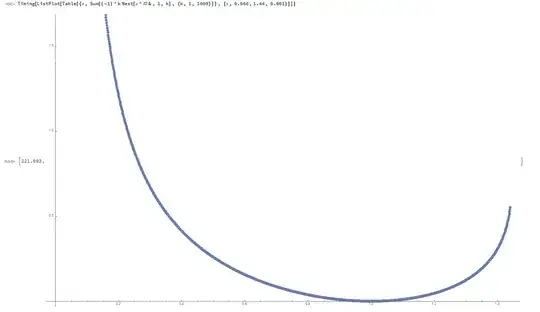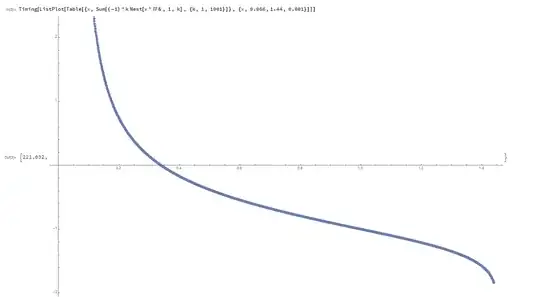During my testing of the series $\sum\limits_{k=1}^{n} (-1)^k(^kx)$, I found that the sum converges to two limits when $n \to \infty$, for $e^{-e} \lt x \le e^{1/e}$ and oscillates between depending on whether $n$ is even or odd.
Here, $^kx$ is tetration. The notation $^kx$ is the same as $x^{x^{x^{....}}}$, which is the application of exponentiation $k-1$ times. Ex. $^3x=x^{x^x}$.
Questions:
$(1)$ What is the maximum and minimum of $\lim\limits_{n\to \infty}\sum\limits_{k=1}^{n} (-1)^k(^kx)$ for even $n$?
$(2)$ What is the maximum and minimum of $\lim\limits_{n\to \infty}\sum\limits_{k=1}^{n} (-1)^k(^kx)$ for odd $n$?
Edit 1:
Also during my testing in PARI, I observed that the sum seems to converge to two values only in the domain of $e^{-e} \lt x \le e^{1/e}$. I think the reason for this maybe is that, since $^{\infty}x$ converges only for $e^{-e} \lt x \le e^{1/e}$, the sum also converges for the same domain. I would appreciate if someone could explain why the sum converges only for $e^{-e} \lt x \le e^{1/e}$.
Edit 2:
With the help of user Vepir, I was able to plot $\lim\limits_{n\to \infty}\sum\limits_{k=1}^{n} (-1)^k(^kx)$ for both even and odd $n$.
Even $n$:
Odd $n$:
Observations from graphs:
$(i.)$ $x=e^{-e}$ is the maximum for $\lim\limits_{n\to \infty}\sum\limits_{k=1}^{n} (-1)^k(^kx)$ for both even and odd $n$ when $e^{-e} \lt x \le e^{1/e}$.
$(ii.)$ $x=1$ is the minimum for $\lim\limits_{n\to \infty}\sum\limits_{k=1}^{n} (-1)^k(^kx)$ for even $n$ when $e^{-e} \lt x \le e^{1/e}$.
$(iii.)$ $x=e^{1/e}$ is the minimum for $\lim\limits_{n\to \infty}\sum\limits_{k=1}^{n} (-1)^k(^kx)$ for odd $n$ when $e^{-e} \lt x \le e^{1/e}$.
Now how can we prove any of the three claims above?

